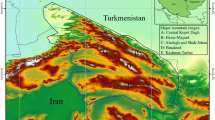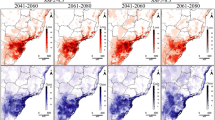Abstract
Climate change poses major new challenges to biodiversity conservation. Distribution ranges of species have been proven to be affected by climate anomalies. Detecting the extent of protected species response to climate change can help formulate flexible conservation strategies to overcome the changing climate. Using species distribution modeling and high resolution climate data, we simulated current distribution patterns of 233 protected plants in China. Those patterns were then projected into future suitable habitats for each species under nine climate change scenarios, with no migration or full migration hypotheses. Under the most extreme climate change scenario (CGCM-B2a), we evaluated species extinction risks. Sixteen percent of protected plants are expected to lose more than 30 % of their current ranges. By calculating areal shifts, hotspots for emigrants, immigrants, and persistent species were identified under climate change. Flexible conservation strategies were addressed for those regions. Those strategies strongly depend on the migration types of species and sensitivity of the hotspots to changing climate. In hotspots for emigrants, the main conservation strategy is ex situ protection; protected species from these regions should be stored in seed banks or botanical gardens. For hotspots of immigrants, enough space should be maintained for new species, and some measures are necessary to assist dispersal. For hotspots of persistent species, more natural reserves are needed. We highlight related fields that can help conserve protected species in the future, such as conserving the soil seed bank and understanding of the effects of migration ability and interactions between protected species.





Similar content being viewed by others
References
The biodiversity committee of Chinese academy of Sciences (2013) Catalogue of life China: 2013 annual checklist China. Science Press, Beijing
Huang JH, Chen B, Liu CR et al (2012) Identifying hotspots of endemic woody seed plant diversity in China. Divers Distrib 18:673–688
Huang JH, Chen JH, Ying JS et al (2011) Features and distribution patterns of Chinese endemic seed plant species. J Syst Evol 49:81–94
Ministry of Environmental Protection of the People’s Republic of China. Biodiversity red list in China-higher plants volume (2013) Ministry of Environmental Protection of China, Chinese Academy of Sciences, http://www.mep.gov.cn
Yu YF (1999) The national key protected wild plants in China. Plants 151:3–11 (in Chinese)
Zhang YB, Ma KP (2008) Geographic distribution patterns and status assessment of threatened plants in China. Biodivers Conserv 17:1783–1798
Yuan H, Liu Y, Zhang YB et al (2009) The in situ conservation of state key protected wild plants in national nature reserves in China. Biodivers Sci 17:280–287 (in Chinese)
Colwell RK, Brehm G, Cardelus CL et al (2008) Global warming, elevational range shifts, and lowland biotic attrition in the wet tropics. Science 322:258–261
Thomas CD, Cameron A, Green RE et al (2004) Extinction risk from climate change. Nature 427:145–148
Sala OE, Chapin FS, Armesto JJ et al (2000) Biodiversity-global biodiversity scenarios for the year 2100. Science 287:1770–1774
Hu JH, Jiang ZG (2011) Climate change hastens the conservation urgency of an endangered ungulate. PLoS One 6:e22873
Bellard C, Bertelsmeier C, Leadley P et al (2012) Impacts of climate change on the future of biodiversity. Ecol Lett 15:365–377
Jones MC, Dye SR, Fernandes JA et al (2013) Predicting the impact of climate change on threatened species in UK waters. PLoS One 8:e54216
Wu JG, Zhou QF, Li Y (2011) Strategies of adaptation to climate change for biodiversity in China. China Popul Res Environ 3:1002–2104
Phillips SJ, Anderson RP, Schapire RE (2006) Maximum entropy modeling of species geographic distributions. Ecol Model 190:231–259
Guisan A, Edwards TC, Hastie T (2002) Generalized linear and generalized additive models in studies of species distributions: setting the scene. Ecol Model 157:89–100
Roberts DR, Hamann A (2012) Predicting potential climate change impacts with bioclimate envelope models: a palaeoecological perspective. Global Ecol Biogeogr 21:121–133
Game ET, Lipsett-Moore G, Saxon E et al (2011) Incorporating climate change adaptation into national conservation assessments. Glob Change Biol 17:3150–3160
Zhang MG, Zhou ZK, Chen WY et al (2012) Using species distribution modeling to improve conservation and land use planning of Yunnan, China. Biol Conserv 153:257–264
Heller NE, Zavaleta ES (2009) Biodiversity management in the face of climate change: a review of 22 years of recommendations. Biol Conserv 142:14–32
FAO (2002) Terrastat; global land resources GIS models and databases for poverty and food insecurity mapping. Land and Water Digital Media Series 20
Graham MH (2003) Confronting multicollinearity in ecological multiple regression. Ecol Lett 84:2809–2815
Pearson RG, Raxworthy CJ, Nakamura M et al (2006) Predicting species distributions from small numbers of occurrence records: a test case using cryptic geckos in Madagascar. J Biogeogr 34:102–117
Zhang MG, Zhou ZK, Chen WY et al (2014) Major declines of woody plant species ranges under climate change in Yunnan, China. Divers Distrib 20:405–415
IPCC (2007) IPCC fourth assessment report: climate change 2007. Intergovernmental Panel on Climate Change, Geneva
Graham CH, Elith J, Hijmans RJ et al (2007) The influence of spatial errors in species occurrence data used in distribution models. J Appl Ecol 45:239–247
Raes N, terSteege H (2007) A null-model for significance testing of presence-only species distribution models. Ecography 30:727–736
Raes N, Roos MC, Slik JWF et al (2009) Botanical richness and endemicity patterns of Borneo derived from species distribution models. Ecography 32:180–192
Liu C, Berry PM, Dawson TP et al (2005) Selecting thresholds of occurrence in the prediction of species distributions. Ecography 28:385–393
Liu C, White M, Newell G (2011) Measuring and comparing the accuracy of species distribution models with presence-absence data. Ecography 34:232–243
Liu C, White M, Newell G et al (2013) Selecting thresholds for the prediction of species occurrence with presence-only data. J Biogeogr 40:778–789
IUCN (2001) IUCN red list categories and criteria: version 3.1. Species Survival Commission, Cambridge
Hole DG, Huntley B, Arinaitwe J et al (2011) Toward a management framework for networks of protected areas in the face of climate change. Conserv Biol 25:305–315
Thuiller W, Lavorel S, Araújo MB et al (2005) Climate change threats to plant diversity in Europe. Proc Natl Acad Sci USA 102:8245–8250
Hernandez PA, Graham CH, Master LL et al (2006) The effect of sample size and species characteristics on performance of different species distribution modeling methods. Ecography 29:773–785
Wisz MS, Hijmans RJ, Li J et al (2008) Effects of sample size on the performance of species distribution models. Divers Distrib 14:763–773
Elith J, Graham CH, Anderson RP et al (2006) Novel methods improve prediction of species’ distributions from occurrence data. Ecography 29:129–151
Pounds JA, Bustamante MR, Coloma LA et al (2006) Widespread amphibian extinctions from epidemic disease driven by global warming. Nature 439:161–167
Parmesan C, Yohe G (2003) A globally coherent fingerprint of climate change impacts across natural systems. Nature 421:37–42
Hannah L, Midgley GF, Millar D (2002) Climate change-integrated conservation strategies. Glob Ecol Biogeogr 11:485–495
Scott D, Malcom J, Lemieux CJ (2002) Climate change and biome representation in Canada’s national park system: implications for system planning and park mandates. Global Ecol Biogeogr 11:475–484
Millar CI, Stephenson NL, Stephens SL (2007) Climate change and forests of the future: managing in the face of uncertainty. Ecol Appl 17:2145–2151
de Dios VR, Fischer CO (2007) Climate change effects on Mediterranean forests and preventive measures. New For 33:29–40
Opdam P, Wascher D (2004) Climate change meets habitat fragmentation: linking landscape and biogeographical scale levels in research and conservation. Biol Conserv 117:285–297
Chambers LE, Hughes L, Weston MA (2005) Climate change and its impact on Australia’s avifauna. Emu 105:1–20
Acknowledgments
This work was supported by the National Natural Science Foundation of China (31100392) and the National Science and Technology Support Program (2012BAC01B05).
Conflict of interest
The authors declare that they have no conflict of interest.
Author information
Authors and Affiliations
Corresponding author
Additional information
SPECIAL TOPIC: Impacts of Climate Change on Biodiversity
Electronic supplementary material
Below is the link to the electronic supplementary material.
About this article
Cite this article
Zhang, Y., Wang, Y., Zhang, M. et al. Climate change threats to protected plants of China: an evaluation based on species distribution modeling. Chin. Sci. Bull. 59, 4652–4659 (2014). https://doi.org/10.1007/s11434-014-0642-6
Received:
Accepted:
Published:
Issue Date:
DOI: https://doi.org/10.1007/s11434-014-0642-6




